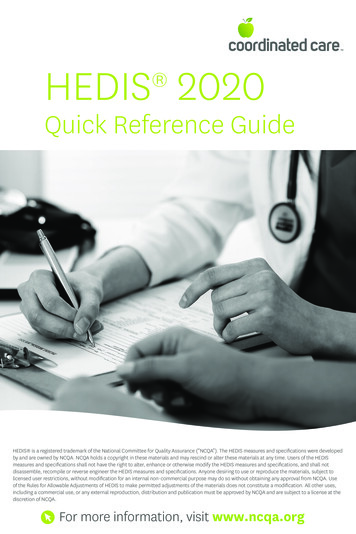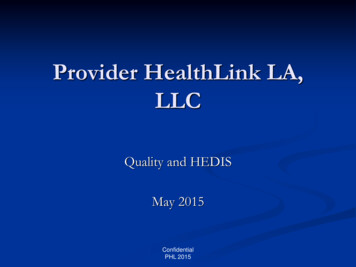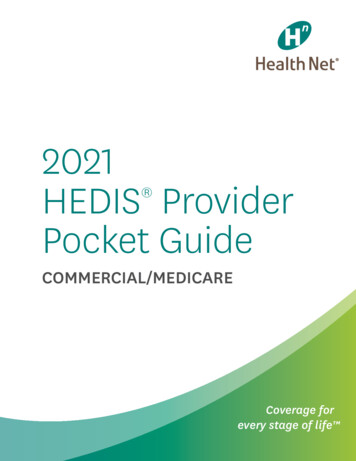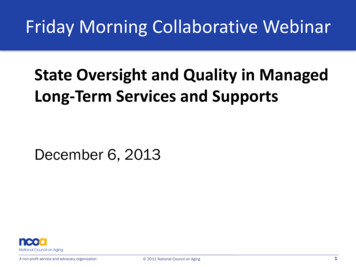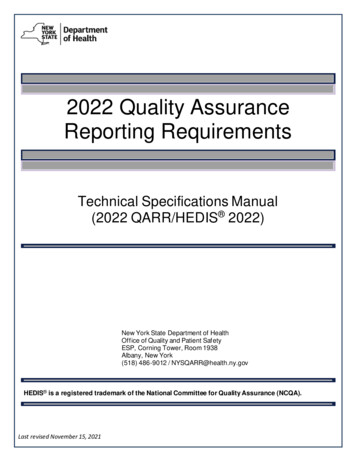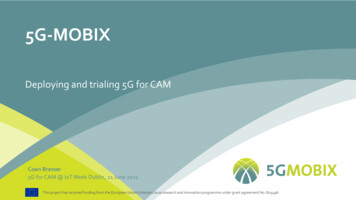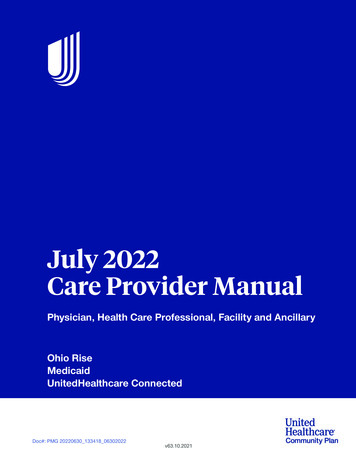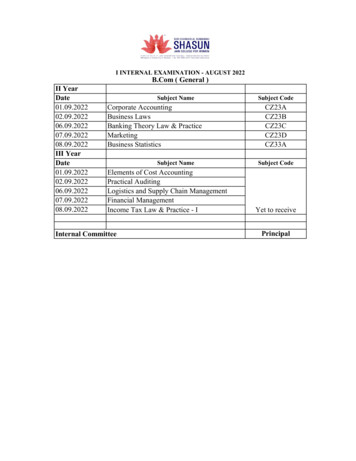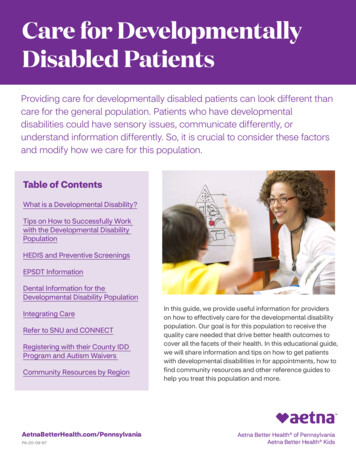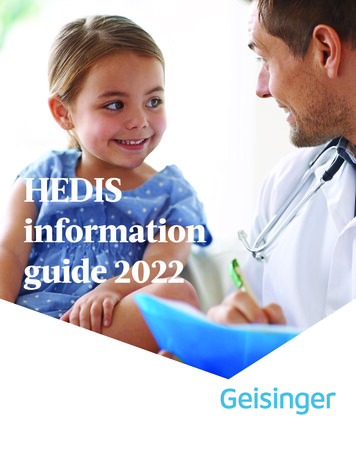
Transcription
HEDISinformationguide 2022
GEISINGER HEALTH PLANQuestions? Here’s who to call.Online servicesQuality and accreditationNaviNet for provider information and resources —NaviNet.navimedix.comCall for medical record chart review and HEDISspecification questions.Instamed for electronic claim submission and paymenttransactions. 866-467-8263Instamed.comQuality and accreditation. 866-847-1216 Provider account managementClaimsTalk to your provider account manager about your contract,pay-for-quality programs and educational opportunities.Call the customer care team with claims questions thatcannot be resolved through NaviNet or Instamed.Provider account management . 800-876-5357GHPAccountMngt@Geisinger.eduProvider claims. 800-447-4000Benefits and eligibilityMedical managementCall for member benefits and eligibility unable to befound via NaviNet .Contact medical management to request precertification/priorauthorization for things like inpatient admissions, outpatientrehabilitation, home health & hospice, SNF or DME.HMO/PPO. 800-447-4000Medical management. 800-544-3907PPO/TPA. 800-504-0443Non-emergent ambulance. 844-749-5860Geisinger Gold. 800-498-9731GHP Family. 855-227-1302Pharmacy departmentGHP Kids (CHIP). 866-621-5235Call the pharmacy department for formulary exceptions, drugauthorization and prescription drug information.EMHS TPA. 855-863-2429Pharmacy department. 800-988-4861AtlantiCare TPA. 866-379-4465GHP Family pharmacy department. 855-552-6028St. Luke’s TPA. 866-580-3531Exchange. 866-379-4489Case managementGeisinger employees. 844-568-5229Contact case management for assistance with care coordination.Wise Foods. 844-260-8028Case management. 800-883-6355AON. 844-390-8332GHP Family Special Needs Program(SNP) unit. 855-214-8100Performance Guarantee. 844-863-6850(Bucknell, FEDS, PA Trst, PEBTF, Walmart)Behavioral health . 888-839-7972PA Relay 711 for hearing impairedDental servicesConnect patients with dentists, oral health education frompublic health dental hygienists and other local resources.Dental line.833-589-21942
GEISINGER HEALTH PLANWhat is HEDIS?HEDIS (Healthcare Effectiveness Data and Information Set) is a set of standardized performance measures, developed by theNational Committee for Quality Assurance (NCQA), which allows direct, objective comparison of quality across health plans.NCQA develops the HEDIS measures through a committee represented by purchasers, consumers, health plans, healthcareproviders and policymakers. HEDIS allows for standardized measurement, standardized reporting and accurate objective sideby-side comparisons. For more information, visit ncqa.org.How to be a Medicarequality superstarWhat is the Medicare Star Ratings system?The Medicare Star Ratings program was created by the Centers for Medicare & Medicaid Services (CMS). It evaluates therelative quality of private health plans that offer services to Medicare beneficiaries. CMS scores health plans on a one- tofive-star rating system. Five stars represents the highest quality a plan can achieve. Members can use this rating system togauge a plan’s quality rating, ease of access to care, provider responsiveness and members’ satisfaction with the health plan.Why is the Medicare Star Ratings system so important? Helps members make informed decisions about healthcare plans Provides richer benefits for members Promotes a higher quality of care for membersMany of the indicators that make up the health plan’s overall Medicare Star Rating are based on the patient-physicianrelationship and related outcomes.Follow these quick tips to become a Medicare Star superstar!Schedule all important preventive care as soon as possible. Colorectal cancer screeningBreast cancer screeningDiabetes careControlling hypertensionMake sure members are receiving appropriate treatment-based care. Perform and document pain assessments.Perform and document medication reconciliation (especially post-discharge from an inpatient/acute event).Consider a DMARD for the treatment of rheumatoid arthritis.Consider a statin therapy regimen for members with cardiovascular disease and diabetes.Promote and encourage medication adherence3
GEISINGER HEALTH PLANWhat is the CAHPS survey?NCQA and CMS require health plans to administer a member satisfaction survey (Consumer Assessment of HealthcareProviders and Systems, or CAHPS ). Survey results are collected annually and compared to national benchmarks. Thesurveys are conducted in early spring by mail and followed up by phone to non-responders. Results are available later in thesummer for commercial and Medicaid health plans and later in the year for Medicare.The CAHPS survey is a key component of the Medicare Star program, currently representing one-third of the health plan’soverall Medicare Star Rating. It asks members and consumers to report on and evaluate their experiences with healthcare.The survey covers topics that are important to consumers and focuses on aspects of quality consumers are most qualifiedto address. Each member is surveyed to gauge their satisfaction with services provided by the health plan and memberperceptions of healthcare provider accessibility, the member-physician relationship and healthcare provider communication.Multiple questions relate to member satisfaction with physicians. These might be of interest, as they pertain to the memberphysician relationship and can highlight opportunities for improvement in everyday practice.The CAHPS survey also contains effectiveness-of-care measures. Members are asked whether they received a flu shot, ifthey got direction from their physician on aspirin usage and if their physician discussed tobacco cessation.Quick tips to help you boost your CAHPS ratingsDon’t keep your members waiting too long. Has the member been in the waiting room for more than 30 minutes?Get to know your members’ special needs. Accommodate those who are frail, elderly, non-English-speaking or who have a disability.Keep in touch with your members. Reach out to members who have not been seen.Allow extra time during appointments for questions and answers.Make sure each member has an annual wellness visit and completes all needed tests and screenings.Follow up with all test results and future appointments.Schedule appointments appropriately. Urgent care – less than 24 hours Non-urgent care – within 1 week Routine/preventive care – within 1 month4
GEISINGER HEALTH PLANWhat is the Health Outcomes Survey?The Health Outcomes Survey, or HOS, is a survey instrument that assesses members’ health status and changes in it overtime. All managed care organizations with Medicare contracts must participate in the HOS. The survey is administeredannually to a random sample of Medicare beneficiaries drawn from each participating Medicare Advantage health plan. Abaseline survey is administered to a new cohort, or group, each year. Two years later, these same respondents are surveyedagain (i.e., follow-up measurement).Among a variety of measures, the HOS is used to collect three HEDIS effectiveness-of-caremeasures: Management of Urinary Incontinence in Older Adults Physical Activity in Older Adults Fall Risk ManagementThese measures are currently included in the Medicare Star Ratings program.To address these measures effectively, be sure to: Talk to your patients about urinary incontinence. Offer them strategies to ease their concerns. Discuss physical activity levels with your patients. As appropriate, advise them to increase their physical activity. Assess your patients for level of fall risk. Offer strategies to support improved balance and to avoid falls.What is a provider’s role in HEDIS?Providers play an essential role in promoting the health of our members. Your office can help increase HEDIS scores bydiscussing the importance of preventive health screenings and exams with our members. Some HEDIS measures are includedin our pay-for-performance programs, so increasing scores may positively impact your payout for these programs. Mostimportantly, reinforcing preventive care compliance with our members will ultimately improve their health outcomes.You can assist by doing the following: Submit claim/encounter data for each service rendered. Chart documentation must reflect services billed. Accurately code all claims. Since HEDIS measures are linked to specific coding criteria, accurate coding is critical. Providingaccurate information may also reduce the number of records requested. Consider including CPT II codes to reduce medical record requests. These codes provide details currently only found in thechart such as BMI screenings and lab results. Avoid missed opportunities by taking advantage of sick care visits; combine the well visit components and use a modifierand proper codes to bill for both the sick and well visit. Routinely schedule a member’s next appointment while in the office for the visit. Respond promptly to our requests for medical records. Encourage our members to get preventive screenings, such as cervical cancer screening, mammography and colorectalcancer screening.5
HEDIS measuresContentsPrevention and screeningsAnnual wellness visit (AWV). 8Breast cancer screening (BCS). 9Cervical cancer screening (CCS). 10Colorectal cancer screening (COL). 11Care for older adults (COA) . 13Chlamydia screening in women (CHL). 14Controlling high blood pressure (CBP). 15Social determinants of health screening (SDOH). 16Children and adolescentsWell-child visits in the first 30 months of life (W30). 19Child and adolescent well-care visits (WCV). 20Weight assessment and counseling for nutrition and physical activity for children/adolescents (WCC). 21Childhood immunization status (CIS). 22Immunizations for adolescents (IMA). 24Lead screening in children (LSC) . 25Annual dental visit (ADV). 26Perinatal screeningsPrenatal care (PPC). 27Postpartum care (PPC) . 29Perinatal depression screening. 31Prenatal screening for smoking and treatment discussion during a prenatal visit. 34Behavioral healthAntidepressant medication management (AMM). 36Follow-up care for children prescribed ADHD medication (ADD). 38Initiation and engagement of alcohol and other drug dependence treatment (IET). 39Adherence to antipsychotic medications for individuals with schizophrenia (SAA). 41Metabolic monitoring for children and adolescents on antipsychotics (APM). 42Follow-up after hospitalization for mental illness (FUH). 44
Medication managementAsthma medication ratio (AMR). 46Statin therapy for members with cardiovascular disease (SPC) . 48Statin therapy for members with diabetes (SPD). 52Persistence of beta blocker treatment after a heart attack (PBH) . 57Potentially harmful drug-disease interactions in the elderly (DDE). 59Use of high-risk medication in older adults (DAE). 63Use of high-risk medication in older adults (DAE). 67Use of opioids at high dosage (HDO). 68Use of Opioids From Multiple Providers (UOP). 70Risk of continued opioid use (COU) . 71Pharmacotherapy management of COPD (PCE). 72Transitions of care (TRC). 73Chronic conditionsHemoglobin A1C control for patients with Diabetes (HBD). 74Blood Pressure Control for patients with Diabetes (BPD) . 75Eye exam for patients with Diabetes (EED) . 76Osteoporosis management in women who had a fracture (OMW)Osteoporosis screening in older women (OSW). 78. 80Overuse/appropriatenessAppropriate testing for pharyngitis (CWP). 81Avoidance of antibiotic treatment for acute bronchitis/bronchiolitis (AAB). 82Appropriate treatment for upper respiratory infection (URI). 83Use of spirometry testing in the assessment and diagnosis of COPD (SPR). 85Measures collected through the CAHPS health plan surveyPneumococcal vaccination status for older adults (PNU). 86AppendicesAppendix 1 — Frailty, advanced illness and dementia medicationsA-1Appendix 2 — Diabetes medicationsA-3Appendix 3 — ACE inhibitor/ARB medicationsA-4Appendix 4 — AAB antibiotic medicationsA-5Appendix 5 — Early childhood screeningsA-6Appendix 6 — Common codes for visit types associated with many measuresA-16
Annual wellness visit (AWV)MedicareThe percentage of members that had one annual well visit as of Dec. 31 of the measurement year.Frequently utilizedprovider best practicesCommon codes forthis measure(Note: Codes listed aresubject to plan coverage andcontracted fee schedule.) Allow enough time for the visit. C MS requires the provider to, at a minimum, collect and document the member’s medicaland surgical and procedural history: Illnesses Hospital stays Operations Allergies Injuries and treatments Medication and supplement (including calcium and vitamins) utilization Opioid use Behavioral risks Activities of daily living (ADLs) Instrumental ADLs (IADLs) Pain assessment Assess cognitive function of member. Risk factors for depression or other mood disorders (depression screenings) R eview member’s functional ability and level of safety by observing or screening thefollowing: Ability to successfully perform ADLs Fall risk Hearing impairment Home safety Urinary incontinence Discuss advance care planning services. Discuss preventive services. M onitoring a member’s physical activity, discuss the health benefits of increasing physicalactivity, develop activity action plans and exercise programs.DescriptionAnnual wellvisitHCPCS:CodesDescriptionG0438Annual wellness visit; includes a personalized preventionplan of service(PPS), initial visitG0439Annual wellness visit includes a personalized preventionplan of service(PPS), subsequent visitG0468Federally qualified health center (FQHC) visit, IPPE orAWV; a FQHC visit that includes an initial preventivephysical examination (IPPE) or annual wellness visit(AWV) and includes a typical bundle of Medicare-coveredservices that would be furnished per diem to a memberreceive an IPPE or AWV. (Only valid when billed withlocation code 50, for our contracted FQHC providers)Common chart deficiencies Not using appropriate codes Completing a yearly physical instead of a Medicare annual wellness visit (AWV)ExclusionsMembers in hospice or using hospice services anytime during the measurement year8
Breast cancer screening (BCS)Commercial, Medicare, MedicaidPercentage of women 50 – 74 years of age who had a mammogram between Oct. 1, 2020 – Dec. 31, 2022.Frequently utilizedprovider best practicesCommon codes forthis measure(Note: Codes listed aresubject to plan coverage andcontracted fee schedule.) Educate female members about the importance of early detection and encourage testing. Document a bilateral or unilateral mastectomy in the medical record. D o not miss the opportunity to schedule a mammogram for the member while at theoffice visit. H ave a list of facilities available for members to choose where they would like to have themammogram scheduled. D iscuss possible fears the member may have about mammograms and explain currenttesting process are less uncomfortable and require less radiation. Transgender population should be counted.DescriptionCodesMammographyCPT:77061, 77062, 77063, 77065, 77066, 77067HCPCS:G0202, G0204, G0206Common chart deficiencies No discussion of scheduling a mammogram No documentation of mammogram date Not ordering mammogram for transgender populationExclusions Members in hospice or using hospice services anytime during the measurement year Members receiving Palliative care anytime during the measurement year Women who had a bilateral mastectomy, unilateral mastectomy with bilateral modifier. Twounilateral mastectomies, or a history of bilateral mastectomy. MUST BE CODED.*For a complete list of exclusions, you may contact your Account Manager.9
Cervical cancer screening (CCS)Commercial, Medicaid, MedicarePercentage of women 21 - 64 years of age who were screened for cervical cancerFrequently utilizedprovider best practicesCommon codes forthis measure(Note: Codes listed aresubject to plan coverage andcontracted fee schedule.) Request to have results of Pap tests sent to you, if done at OB/GYN visits. D ocument in the medical record if the member has had a hysterectomy with no residualcervix, and fax us the chart.DescriptionCodesCervicalCytologyCPT:88141, 88142, 88143, 88147, 88148, 88150, 88152, 88153,88154, 88164, 88165, 88166, 88167, 88174, 88175HCPCS:G0123, G0124, G0141, G0143, G0144, G0145, G0147, G0148,P3000, P3001, Q0091CPT:87624, 87625HCPCS:G0476HPVCommon chart deficiencies Documentation of hysterectomy alone does not meet guidelines. Do not use active cancer codes for screenings, unless member is actively being treated for cancer.Exclusions Members in hospice or using hospice services anytime during the measurement year Members under palliative care Members who had a hysterectomy with no residual cervix*For a complete list of exclusions, you may contact your Account Manager.10
Colorectal cancer screening (COL)Commercial, MedicareThe percentage of members 50 – 75 years of age who had appropriate screening for colorectal cancer: Colonoscopy between 2012 and 2021 Flexible sigmoidoscopy or CT colonography between 2017 and 2021 Fecal occult blood test in 2021 FIT/DNA Cologuard between 2019 and 2021Frequently utilizedprovider best practicesCommon codes forthis measure(Note: Codes listed aresubject to plan coverage andcontracted fee schedule.) Recommend FOBT/FIT-DNA as an alternative to colonoscopy. Provide ongoing outreach and education to non-compliant members. U se standing orders and empower office staff to distribute FOBT or FIT kits to memberswho need colorectal cancer screening or prepare referral for colonoscopy.DescriptionCodesFOBTCPT:82270, 82274FlexibleSigmoidoscopyCPT:45330, 45331, 45332, 45333, 45334, 45335, 45337, 45338,45340, 45341, 45342, 45346, 45347, 45349, 45350ColonoscopyCPT:44388, 44389, 44390, 44391, 44392, 44393, 44394, 44397,44401, 44402, 44403, 44404, 44405, 44406, 44407, 44408,45355, 45378, 45379, 45380, 45381, 45382, 45383, 45384,45385, 45386, 45387, 45388, 45389, 45390, 45391, 45392,45393, 45398CTColonographyCPT:74261, 74262, 74263FIT - DNA(Cologuard)CPT:81528Common chart deficiencies Not labeling scanned colonoscopies in EMR appropriately Not documenting and updating dates of screenings/colonoscopies in chartExclusions D iagnosis of colorectal cancer or total colectomy any time prior to Dec. 31 ofmeasurement year. Members enrolled in an institutional SNP any time during the year Members in hospice or using hospice services anytime during the measurement year Members under palliative care Members with a frailty diagnosis*For a complete list of exclusions, you may contact your Account Manager.(Cont. on next page.)11
Colorectal cancer screening (COL)(continued)Exclusions(cont.)Medical recorddocumentationCommercial, MedicareExcluded codes*ColorectalCancerCPT:G0213, G0214, G0215, G0231ICD10:C18.0, C18.1, C18.2, C18.3, C18.4, C18.5, C18.6, C18.7, C18.8,C18.9, C19, C20, C21.2, C21.8, C78.5, Z85.038, Z85.048TotalColectomyCPT:44150, 44151, 44152, 44153, 44155, 44156, 44157, 44158,44210, 44211, 44212HCPCS:0DTE0ZZ, 0DTE4ZZ, 0DTE7ZZ, 0DTE8ZZMedical record dates:Fax medical record information to Geisinger Health Plan Quality Department at 570-214-1380. Colonoscopy between 2013 and 2022 Flexible sigmoidoscopy or CT colonography between 2018 and 2022 Fecal occult blood test in 2022 FIT/DNA Cologuard between 2020 and 2022 Dated documentation of a colon screening on a medical history form, problem list or healthmaintenance form If applicable, documentation of colorectal cancer or a total colectomy with dateof occurrence.12
Care for older adults (COA)MedicareThe percentage of adults 66 years and older who had each of the following during the measurement year: Medication review Functional status assessment Pain assessmentFrequently utilizedprovider best practices Common codes forthis measureDescriptionCodesMedication reviewCPT:90863, 99483, 99605, 99606CPT II:1160FCPT II:1159FHCPCS:G8427CPT:99483CPT II:1170FHCPCS:G0438, G0439CPT:1125F, 1126F(Note: Codes listed aresubject to plan coverage andcontracted fee schedule.)Use CPT II codes to capture completed services.Services rendered during a telephone visit, e-visit or virtual check-in meet criteria forfunctional status and pain assessment Remember the medication review measure requires medications are listed in the chart, plusthe review. Incorporate a standardized template to capture these measures for members 66 years andolder, if on EMR.Medication listFunctional statusassessmentPain assessmentCommon chart deficiencies Not documenting conversations that take place during visits Not documenting how the patient ambulates into the office, arrives, etc. Not documenting hearing, vision, etc. under review of systems; stating "normal" under eyes, nose, etc. does not countExclusions Members in hospice or using hospice services anytime during the measurement year13
Chlamydia screening in women (CHL)Commercial, MedicaidThe percentage of women 16 – 24 years of age who were identified as sexually active and who had at least one test forchlamydia during the measurement yearFrequently utilizedprovider best practicesCommon codes forthis measure(Note: Codes listed aresubject to plan coverage andcontracted fee schedule.) P erform chlamydia screening every year on every female age 16 – 24 years (use anyvisit opportunity). A dd chlamydia screening as a standard lab for women 16 – 24 years old. Use well-childexams and well women exams for this purpose. Remember that chlamydia screening can be performed through a urine test.DescriptionCodesChlamydia screeningCPT:87110, 87270, 87320, 87490, 87491, 87492, 87810T
Management of Urinary Incontinence in Older Adults Physical Activity in Older Adults Fall Risk Management These measures are currently included in the Medicare Star Ratings program. To address these measures effectively, be sure to: Talk to your patients about urinary incontinence. Offer them strategies to ease their concerns.
